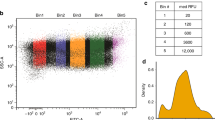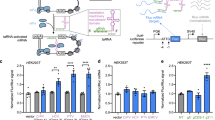Abstract
The study of translational control has become increasingly important, as aberrant translation has been linked to the etiology of human diseases. Nevertheless, a convenient research tool to measure and quantify cellular translational activity has not been developed to date. Here we present a translation control reporter system (TCRS) for straightforward and accurate analysis of cellular translational activity. Our method relies on the expression of two unique reporter peptides from a single messenger RNA transcript. Using TCRS-expressing cell lines, changes in initiation of translation have been detected in response to translationally active drugs. Accordingly, TCRS may promote the discovery of novel agents that modulate translation. TCRS may also be used in the identification of signal transduction pathways that impinge on translation control. Furthermore, the modular design allows the exchange of regulatory cassettes for the examination of other putative cis-regulatory mRNA elements. The time required for the procedure depends on whether transient TCRS expression is used or stable TCRS-expressing cell lines have to be produced and will range from 5 to 14 d, respectively.
This is a preview of subscription content, access via your institution
Access options
Subscribe to this journal
Receive 12 print issues and online access
$259.00 per year
only $21.58 per issue
Buy this article
- Purchase on Springer Link
- Instant access to full article PDF
Prices may be subject to local taxes which are calculated during checkout



Similar content being viewed by others
References
Calkhoven, C.F., Muller, C. & Leutz, A. Translational control of gene expression and disease. Trends Mol. Med. 8, 577–583 (2002).
Pandolfi, P.P. Aberrant mRNA translation in cancer pathogenesis: an old concept revisited comes finally of age. Oncogene 23, 3134–3137 (2004).
Ausubel, F.M. et al. Current Protocols in Molecular Biology (John Wiley & Sons, Inc., USA, 2005).
Hennecke et al. Composition and arrangement of genes define the strength of IRES-driven translation in bicistronic mRNAs. Nucleic Acids Res. 29, 3327–3334 (2001).
Calkhoven, C.F., Muller, C. & Leutz, A. Translational control of C/EBPalpha and C/EBPbeta isoform expression. Genes Dev. 14, 1920–1932 (2000).
Hinnebusch, A.G. Translational regulation of GCN4 and the general amino acid control of yeast. Annu. Rev. Microbiol. 59, 407–450 (2005).
Vattem, K.M. & Wek, R.C. Reinitiation involving upstream ORFs regulates ATF4 mRNA translation in mammalian cells. Proc. Natl. Acad. Sci. USA 101, 11269–11274 (2004).
Kozak, M. A second look at cellular mRNA sequences said to function as internal ribosome entry sites. Nucleic Acids Res. 33, 6593–6602 (2005).
Sachs, M.S. & Geballe, A.P. Downstream control of upstream open reading frames. Genes Dev. 20, 915–921 (2006).
Morris, D.R. & Geballe, A.P. Upstream open reading frames as regulators of mRNA translation. Mol. Cell. Biol. 20, 8635–8642 (2000).
Holz, M.K., Ballif, B.A., Gygi, S.P. & Blenis, J. mTOR and S6K1 mediate assembly of the translation preinitiation complex through dynamic protein interchange and ordered phosphorylation events. Cell 123, 569–580 (2005).
Wiesenthal, V., Leutz, A. & Calkhoven, C.F. A translation control reporter system (TCRS) for the analysis of translationally controlled processes in the vertebrate cell. Nucleic Acids Res. 34, e23 (2006).
Hay, N. & Sonenberg, N. Upstream and downstream of mTOR. Genes Dev. 18, 1926–1945 (2004).
Acknowledgements
This work was supported by a Max Delbrück Centre grant to V.W. and a Deutsche Forschungsgemeinschaft grant to A.L. and C.F.C. (LE 770/3-2).
Author information
Authors and Affiliations
Corresponding author
Ethics declarations
Competing interests
The TCRS system is subject to the patent applications DE 10104952, EP 1360331, US 2004/0101888 and JP 2004-522443, assigned to the Max Delbrück Centre for Molecular Medicine (MDC) in Berlin, Germany.
Rights and permissions
About this article
Cite this article
Wiesenthal, V., Leutz, A. & Calkhoven, C. Analysis of translation initiation using a translation control reporter system. Nat Protoc 1, 1531–1537 (2006). https://doi.org/10.1038/nprot.2006.274
Published:
Issue Date:
DOI: https://doi.org/10.1038/nprot.2006.274
This article is cited by
Comments
By submitting a comment you agree to abide by our Terms and Community Guidelines. If you find something abusive or that does not comply with our terms or guidelines please flag it as inappropriate.



